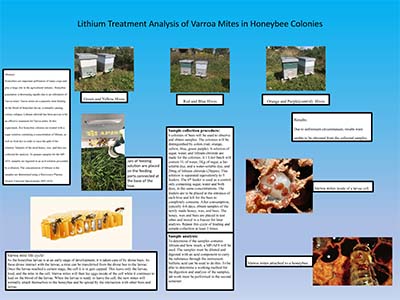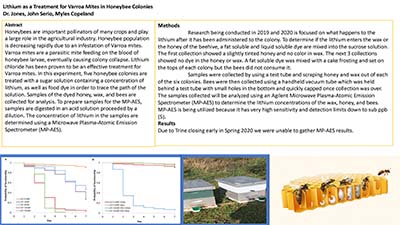Undergraduate Research Projects
Below are undergraduate research projects completed by members of the Class of 2020 through the Rinker-Ross School of Health Sciences. Click images for full-size versions of research posters.
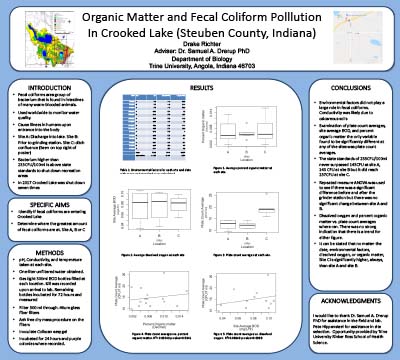 Organic Matter and Fecal Coliform Pollution In Crooked Lake (Steuben County, Indiana), supervised by Sam Drerup, Ph.D.
Organic Matter and Fecal Coliform Pollution In Crooked Lake (Steuben County, Indiana), supervised by Sam Drerup, Ph.D.
Drake was interested in fecal coliform contamination entering Crooked Lake. Drake collected field samples from November 2019-February 2020. He measured organic matter in the stream, likely fecal coliform load, and bacterial load in the water sampled. He found total contamination did not vary between sampling dates suggesting contamination is from a consistent source (septic systems).
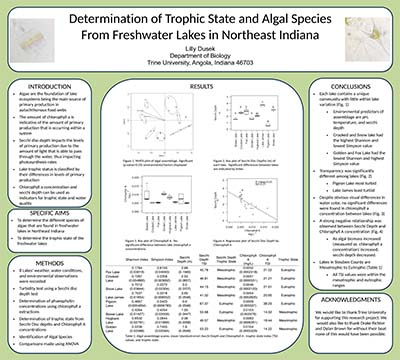 Determination of Trophic State and Algal Species From Freshwater Lakes in Northeast
Indiana, supervised by Sam Drerup, Ph.D.
Determination of Trophic State and Algal Species From Freshwater Lakes in Northeast
Indiana, supervised by Sam Drerup, Ph.D.
Lily sampled surface water from eight lakes within Steuben County, Indiana. She measured environmental parameters (pH, conductivity, and transparency using Secchi Disk) as well as collected samples for algal biomass (chlorophyll a concentration) and community composition. She found that all lakes sampled showed signs of nutrient enrichment and that each lake had a unique community of phytoplankton.
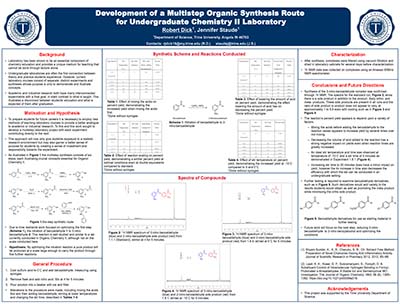 Development of a Multistep Organic Synthesis Route for Undergraduate Organic Chemistry
II Laboratory, supervised by Jennifer Staude, Ph.D.
Development of a Multistep Organic Synthesis Route for Undergraduate Organic Chemistry
II Laboratory, supervised by Jennifer Staude, Ph.D.
Current undergraduate organic chemistry II laboratories lack an adequate analogue to graduate and industry work. Thus, a multistep organic synthesis route combining currently used organic reactions will provide a novel laboratory experience and improve the student laboratory experience. The work describes the optimization of the first reaction, the nitration of benzaldehyde, for high purity and efficiency. The optimal conditions found are conducting the reaction at -10 ̊C for 5 minutes and mixing the nitric and sulfuric acids before adding benzaldehyde, which gives a 74% yield.
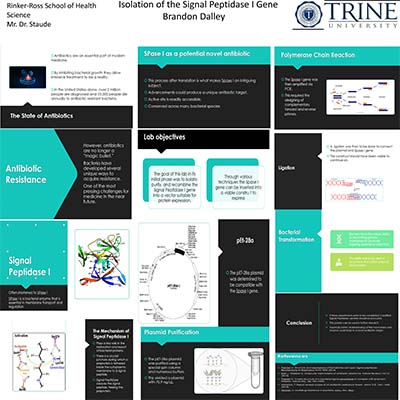 Generation of an expression vector for the E.coli SPaseI, supervised by Michael Staude, Ph.D.
Generation of an expression vector for the E.coli SPaseI, supervised by Michael Staude, Ph.D.
Brandon Dalley was attempting to construct an expression vector by recombining the DNA of an essential bacterial protein (SPaseI), responsible for the export of virulent and other essential proteins, with a commercially available expression vector using common molecular biology techniques.
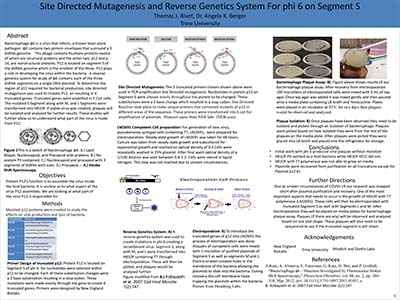 Site Directed Mutagenesis and Reverse Genetics system for Phi 6 on Segment S, supervised by Angela Berger, Ph.D.
Site Directed Mutagenesis and Reverse Genetics system for Phi 6 on Segment S, supervised by Angela Berger, Ph.D.
Bacteriophage phi 6 is a virus that infects the plant pathogen Pseudomonas syringae. Our study focused on the importance of the nonstructural protein p12 in virus production. We generated truncated versions of the p12 protein through site-directed genomic mutagenesis. These mutated genomes will be combined in host cells to produce mutant recombinant viruses for identification of the region of p12 required for formation of the virus.
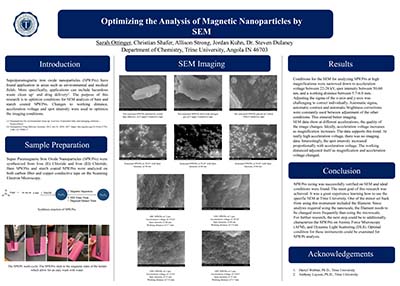 Optimizing the Analysis of Magnatic Nanoparticles by SEM, supervised by Steven Dulaney, Ph.D.
Optimizing the Analysis of Magnatic Nanoparticles by SEM, supervised by Steven Dulaney, Ph.D.
Superparamagnetic iron oxide nanoparticles (SPIONs) were synthesized and analyzed under the Scanning Electron Microscopy (SEM) to optimize imaging conditions for analysis.
